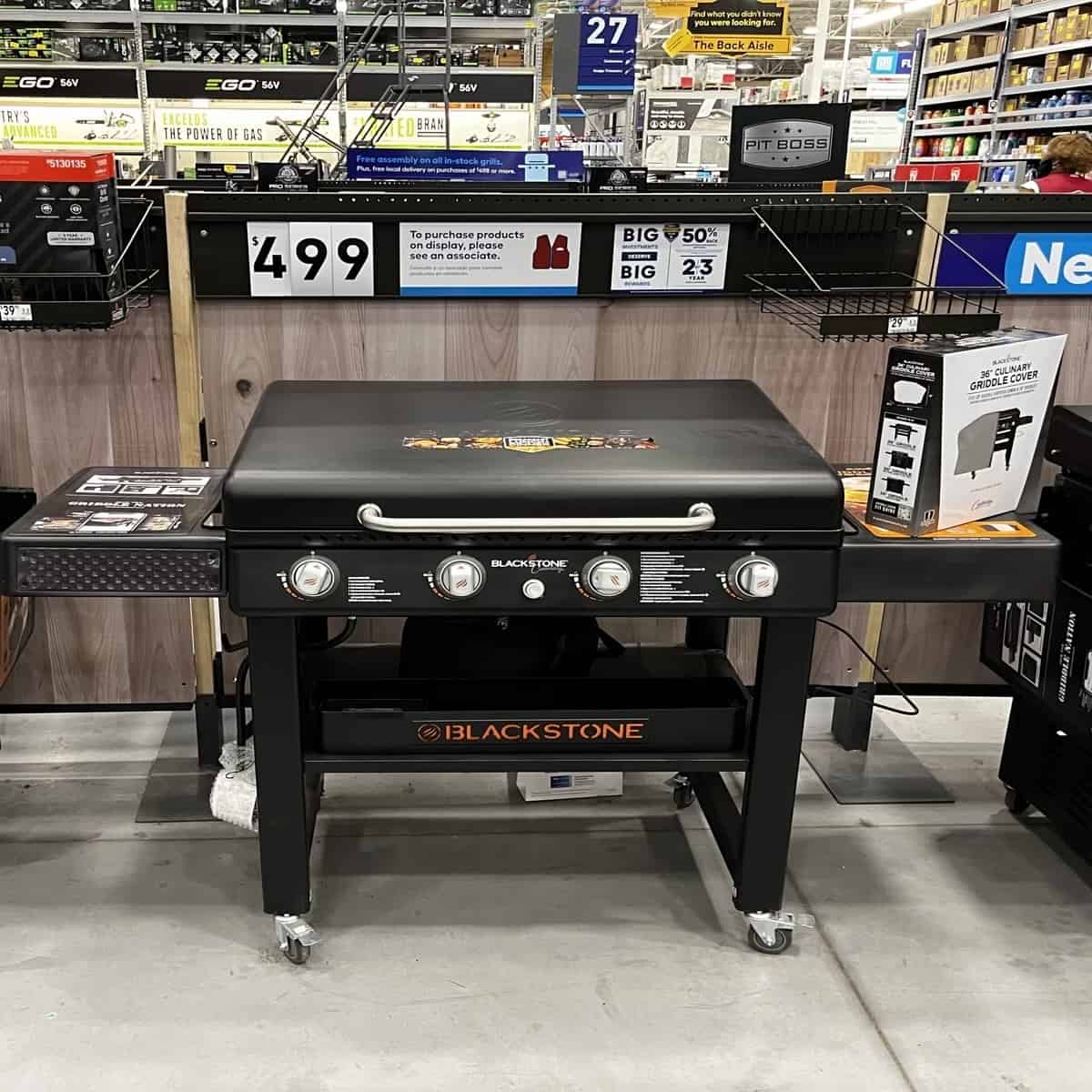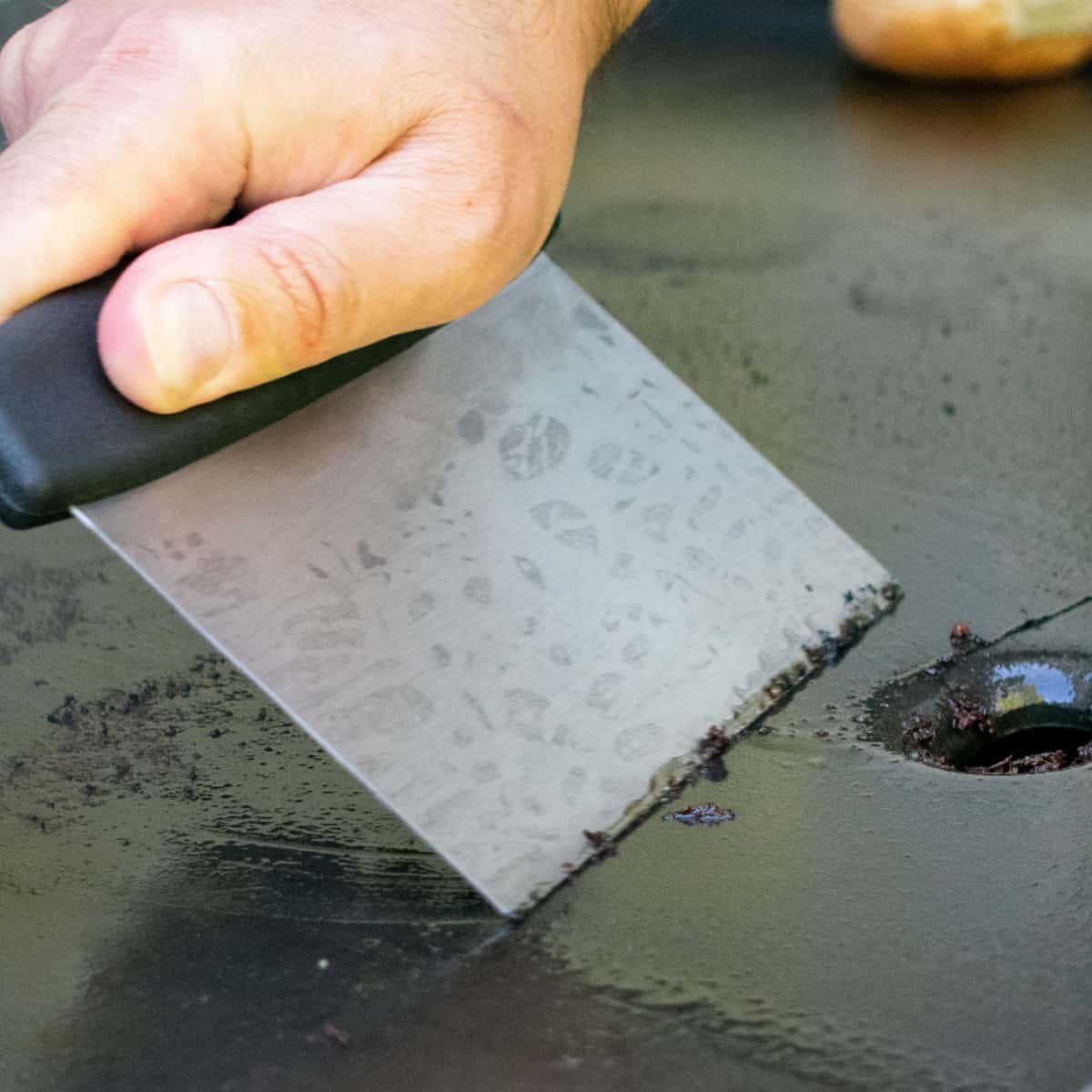Blackstone griddles are pretty widely recognized for being some of the best griddles you can get. They have a good-sized cooking surface, come with a range of different accessories and optional features to help make them more effective, and are available at different price points.
All of those features help make these griddles accessible and effective.

But, no griddle, no kitchen appliance, can do everything. Here are some of the most common mistakes you can make on your Blackstone. Any or all of these mistakes can ruin your cookout.
Remember, having a griddle is like any other kitchen appliance, and regular maintenance is an important part of keeping it working the way it should.
Here’s what you need to know:
Blackstone Mistakes That Can Ruin Your Cookout:
There are a lot of things that can ruin a cookout. Rainstorms, bugs, not knowing about a guests’ allergies or dietary preferences. All of those are understandable problems, sometimes unavoidable ones. But your cooking appliances shouldn’t ever be the problem.
Here’s what you need to know about your Blackstone to avoid some of the most common Blackstone mistakes.
Not Properly Seasoning Your Blackstone Griddle
Like all griddles, Blackstone griddles need to be seasoned. Seasoning not only helps to provide the non-stick cooking surface you want on a good griddle, but it is also critical for protecting your griddle and preventing problems like flaking and rust.
Seasoning is naturally restored with proper cooking and works both as a non-stick surface and to repel water and help prevent oxidation.
It’s formed when oils are heated on the surface for a long time, allowing most of the moisture to evaporate out of the oil, and the lipids and other components to carbonize, creating a thin, usually shiny, or black coating on your griddle surface. This is also critical for grill racks and cast-iron cookware.
You should season your griddle before using it for the first time, and then occasionally season it throughout its working life. Keep an eye on the seasoning and watch for sticky spots since that can be a sign that the seasoning is starting to strip off that portion of the griddle.
Not Using Enough Oil
Not using enough oil when you cook can be another big problem when you’re cooking on a griddle. Remember, when you’re cooking on a griddle, some of the oil is for your food, and some of the oil is for your griddle.
For griddle pasta dishes, vegetables, and fruits, and almost anything that doesn’t produce its own grease, having some oil helps evenly cook your food. It also helps prevent sticking and can make it easier to tell when your food is ready to go.
If you’ve ever been to a Mongolian grill you’ve probably seen the pitmasters there tossing oil and water on food while it cooks, monitoring heat, preventing sticking, and creating steam to give you even results.
While we don’t necessarily recommend water on a Blackstone, especially until you are more experienced with your griddle, adding oil can be a critical part of this process.
It’s also important to choose what oil you want to use. Most will work, but you ideally want oil with a high smoke point, and to avoid oils that can leave a sticky residue like coconut oil.
Only Having One Bottle Of Propane
One of the most common beginner mistakes is thinking that you only need a single bottle of propane to make your griddle work. The thing is, even the largest bottles have a finite capacity, and, sooner or later, you’re going to run out of gas in the middle of cooking.
You don’t want that to happen during your weekend cookout, especially not if you have guests.
Having a second tank makes it easier to swap out the tank and keep cooking. Just remember to make sure you refill or replace your old propane tanks since an empty backup won’t save you!
Not Knowing The Heat Zones On Your Griddle
Even if your griddle is technically one single heat zone and you don’t have separate temperature controls, you will have heat zones.
That’s because griddles aren’t heated evenly over the entire surface. Everything will get hot, but that doesn’t mean that every square inch will be the same temperature.
There are things you can do to test where your Blackstone is hottest and coldest to develop a mental map of your heat zones. But, especially if you have some grilling or griddle experience, you can also get a sense of the heat zones on your griddle with a little experience cooking on that particular griddle.
Heat zones are important because they can not only change how long it takes for your food to cook but also how your food cooks. If your food is on a surface that is too hot, you might burn the outside without cooking the inside. If you cook on a part of the griddle that’s too cold you might not get a good sear, or have to cook a lot longer than anticipated, which can ruin your serving timing.
Putting Flammable or Meltable Objects On The Sides Of Your Standing Blackstone
A lot of standing Blackstone griddles (and griddles from other brands too) have small tables on the sides of the griddle. Those are helpful, but they aren’t good for everything.
The side tables usually do heat up. Not as much as the griddle top, but enough to damage or destroy flammable and meltable objects on them.
That can mean ruined food, burnt fingers, and other problems if you put the wrong object on those tables.
If you need extra storage space, it’s a good idea to get a folding table or something similar that you can use in addition to the storage provided on the griddle.
Heating Your Griddle Too Quickly
A lot of people want to cook on a griddle because of the high-temperature cooking similar to a grill. The problem is that heating up your griddle too quickly won’t make cooking easier (and can make it harder since some things will cook too quickly, leaving the insides raw), it’s also difficult to cool down a too-hot griddle.
Turning up the temperature is a lot easier than turning it down.
Heating up a griddle too quickly can also make it more prone to warping, especially if you haven’t owned the griddle for very long or haven’t used it recently.
Instead, start your griddle on low and increase the temperature only if you need to. And don’t heat it super quickly. Make small adjustments until you have a good cooking temp.
Letting Food Sit Too Long
One of the biggest cooking mistakes on a Blackstone is leaving food in the same spot for too long. For some things like steaks and burgers, stationary cooking can help the meat sear and give you a good Maillard reaction. But it also gives a much larger risk of burning.
Cooking other things, like pancakes, pasta, fruits, veg, or finely chopped foods, without moving or flipping them is a recipe for burning.
Think of your griddle as something like a flat wok. You want to leave food in one place for the minimum amount of time to cook it properly. Flipping, mixing, stirring, and moving the food around on the griddle will help it cook more evenly, and also help you get more than one sear on your food.

Cleaning Your Griddle Too Thoroughly After Cooking
Cleaning your griddle is important when you’re cooking but cleaning it too much can cause a serious problem. That’s because when you clean it too thoroughly or use too much water or the wrong cleaner, you can strip off the seasoning.
Getting rid of the seasoning over time can leave your griddle prone to rust, warping, and flaking into your food.
The good news is that you can re-season your griddle if you accidentally strip the seasoning off your griddle. The bad news is that it can be easy to miss sticky spots, scratches, and thinning, the three most common signs that your seasoning is wearing out.
Leaving Your Griddle Outside Before Cooking On It
Griddles need to get used to the heating and cooling cycle before the metal inside fully stabilizes and learns how to hold its shape.
Cooking several times at a low to moderate temperature, and then a couple of times at a higher temperature, and letting the griddle cool is critical. It helps prevent warping and protects the griddle long-term.
A lot of people buy a griddle, put it somewhere outside in the sun, and then forget about it. This is a recipe for warping. The temperature changes of the weather, without having stabilized during cooking, can make the metal curl.
So, don’t let your griddle sit idle. Make sure to use it at least 10 times before letting it sit for more than a week outside without using it.
Using Frozen Food Directly On The Griddle
Another common temperature problem that happens on griddles is when people use frozen food directly on the griddle.
Now, an old, well-seasoned, well-used griddle can handle the occasional bag of frozen food. But a new griddle, especially one that hasn’t been used much, can warp if you try to cook frozen foods on it.
Unfortunately, the stress on the metal might not show up right away either, so you can have the griddle warp days or weeks later, and have no idea what actually caused the problem.
Instead of cooking frozen foods, whenever possible, thaw them to room temperature first. If you can’t do that, even getting it above freezing at refrigerator temperatures can help protect your griddle.
Not Protecting Your Griddle From Rust
Your griddle can very much rust in the wrong conditions. Seasoning helps to prevent that, but even if you haven’t been able to properly season your griddle you should still do something to help protect it. A quick seasoning treatment can help.
If you don’t have time to fully season your griddle, you can also just oil the griddle and surrounding metal surfaces. You’ll need to clean the oil off before you use the griddle again, but it will at least help prevent the worst of the rust. If your griddle does still rust despite the oil, it should be much less rust than it would otherwise have.
Less rust is a lot easier to deal with than a lot of rust.
Cooking On Your Blackstone Helps Keep It Working Better
One of the things that helps to keep your Blackstone in top working condition is also the simplest. Cooking!
Not sure what to make on your Blackstone?
Well, here are 25 of the Best Blackstone Griddle Recipes to help inspire you. Want more tips and tricks first? Well, we have you covered, here are some of the top tips and tricks, straight from the chefs who use them.


I love my blackstone griddle. It was a Christmas present from my granddaughter and it cooks great. Never will be without one again